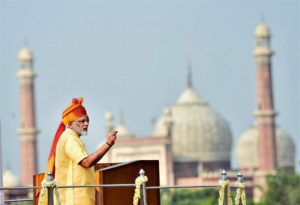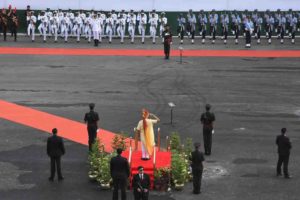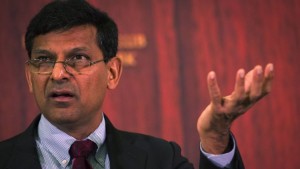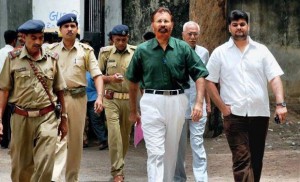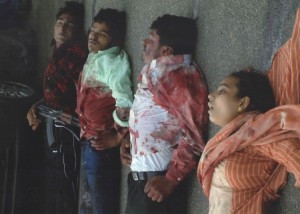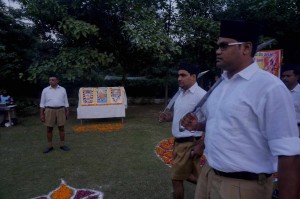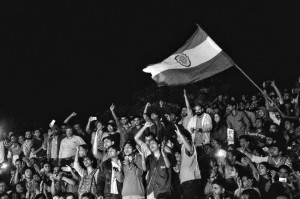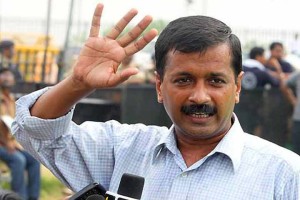
Delhi’s political fishbowl has greeted Chief Minister Arvind Kejriwal’s televised warning that prime minister Modi could get him killed with incredulity. “Has he lost his senses, or is this a clever political gambit in the intensifying the struggle between AAP and the BJP in Delhi”?
Its confusion is partly a product of the way Kejriwal’s statement has been reported—with barely a minute worth of excerpts on the TV channels overlaid with the anchor’s own incomprehension, and in short news items on the front pages of the major dailies. But Kejriwal’s full, nearly ten minute, televised statement is anything but delusional, and conveys an entirely different, chilling, message.
In brief it is this – the Modi government has been trying to incapacitate the AAP government in Delhi ever since its humiliating defeat in Delhi in December 2014, and has been failing miserably. But instead of desisting, it has only become more frantic, harming itself more and more with the electorate. Mr. Modi knows perfectly well that this is happening. So why is he persisting?
Kejriwal’s answer is deeply unsettling: it is because Narendra Modi’s actions are governed by an anger that mounts as his frustration grows. This is pushing him into acts that he knows can only harm his party. India’s national interest has already become a casualty: By imposing an oil blockade on Nepal when it was still struggling to recover from last year’s earthquake, Modi has destroyed India’s relationship with the only Hindu country in the world. He has also reversed a full decade of work by two Indian prime ministers to bring Pakistan and India closer together and end the Kashmir dispute.
Within the nation, Modi’s behavior towards the Delhi government has shown that, when angered, he may stop at nothing to have his way. Kejriwal dramatized this by saying that ‘he might even kill me’. But his deeper message was that when angered Modi showed scant respect for the law and the Constitution.
Is this political theatre a curtain raiser for the battle in Punjab and UP next year? Kejriwal would not be in politics if he did not have them at the back of his mind. But he knows that the credibility of everything he says depends upon his ability to prove his allegations against the BJP in Delhi. He has thrown caution to the winds because he knows that he is on firm ground.
Reports of the BJP’s onslaught on the Delhi state government have appeared in scattered, usually brief, news items spread over almost two years. The underlying issues have been further obscured by being presented to the public as a personal war between Kejriwal and Lieutenant Governor Najib Jung, i.e an opportunistic politician and an arrogant bureaucrat. It is only when we create a timeline for the onslaught that its full, systematic nature gets revealed.
The first conflict occurred as early as March 2015, within four weeks of the new government coming to power. When the chief secretary of Delhi went on leave for eleven days, instead of allowing Kejriwal to appoint his temporary substitute Jung forced Kejriwal to accept Shakuntala Gamlin, the Power secretary, even though this was to be an appointment for only eleven days. The pettiness of Jung’s action led to widespread speculation about its possible causes. But before long it became clear that this was the opening salvo in what was to be a long war.
The conflict was triggered by Kejriwal’s bid to end the rampant, predatory, extortion in all arms of government. During his first 49-day term in office in 2014 his invitation to the public to record any request for a bribe had brought extortion by the police, and municipal officials, down to a trickle.
So in February 2015 one of Kejriwal’s first acts was to set up a helpline where people could report such cases. Within the first 100 hours this received 32,489 calls. Of these 70 were backed with sufficient prima facie evidence to merit being passed on to the Anti-Corruption Branch. Of those 90 percent were against the police or officials of the three municipal corporations in Delhi. By April 18, the ACB had arrested 17 officials of the state government.
The Delhi police had watched these developments with mounting concern. Between April 5 and May 6 the helpline received another 125,000 calls. In an attempt to shelter the police from the deluge the police commissioner, B.S. Bassi, sent three impugned senior officers on forced leave.
But the conflict came to a head on May 1, when the ACB arrested a head constable for demanding a bribe of Rs 20,000 from a used car salesman. In a move that was without precedent the Delhi police immediately filed a case of kidnapping against the Anti Corruption Branch of the State government. Three days later the Police commissioner, B.S Bassi, phoned the head of the ACB and asked him not to forward the case to the vigilance department, but to transfer it to him for a departmental inquiry.
When the ACB chief, S.S Yadav, demurred, Jung demanded that the ACB should report to the LG and not to the state government’s vigilance department. When Kejriwal resisted this, Jung, in another move without precedent, called in a paramilitary force to surround and seize the ACB’s offices, and appointed Joint commissioner of Police Mukesh Meena in Yadav’s place. By choosing Meena, Jung waved a red rag in front of the bull, because Meena had earlier been entrusted with preparing a case against Kejriwal and the AAP for allegedly encouraging farmer Gajendra Singh to hang himself during an AAP rally at Jantar Mantar in August 2014.
Forced out of the ACB office and deprived of control over the police assigned to it, the Delhi government tried to operate the ACB from another location and get policemen from Bihar to staff it. Such transfers of cadres by one state government to another had been requested before and readily conceded, so Bihar CM Nitish Kumar quickly agreed and seconded five police persons to staff it. But Jung stepped in again, asserted that the ACB was now under him, and sent them back to Bihar. The Union Home ministry, unsurprisingly backed Jung, and accused Kejriwal of unnecessarily picking fights with the LG.
On May 21, 2015 the Union Home ministry followed this up with a notification that completely stripped the state government of its power to appoint, promote or transfer of officers in the state administration and vested all of these in the Lieutenant Governor.
A single judge bench of the Delhi High court ruled four days later that in doing so Jung had exceeded the authority given to him by the Constitution in the 69th amendment, which created Delhi State, but since he gave this opinion while hearing the bail application of the Head Constable in the May 1 bribery case, the Central government was able to get an injunction from the Supreme court to disregard it as it had been given on an unrelated matter. Knowing that public anger would serve his cause better, Kejriwal did not file an appeal against the Centre’s notification in the High court, and let the matter rest.
The May 21 notification took away the last shred of the Delhi government’s control over its officers. So when, seven months later on December 30, two senior officers belonging to the Delhi and Andaman Nicobar Service (DANICS) and employed in the State’s Home ministry refused to sign an order passed by the cabinet, stating that they had been given instructions to follow orders only from the LG, Kejriwal decided to suspend them.
Eight days earlier, the Home ministry had issued a notification that had been a year in the making, to protect IAS officers from summary transfers and suspensions by state governments by making these subject to review by the Union Home ministry. This was a much needed reform but did not apply to officers of the DANICS.
Despite that, within hours, the LG sent a letter to the Delhi chief secretary stating that the suspension was ‘illegal’ because it has been done “without the authority of Law”. The Union Home ministry also declared the suspension “ non est” i.e deemed not to exist, at the same time.
This completed the destruction of the executive powers of the Delhi administration. Emboldened by this notification, 200 officers of the DANICS cadre, supported by the IAS officers association, decided to go on a day’s leave en masse,in protest against the suspensions. Kejriwal condemned this as yet another conspiracy against Delhi’s people, but the Modi government did not stop there.
To rub still more salt into the wound the Home ministry began to transfer state government officials in critical positions without warning and without informing the chief minister and his cabinet, let alone seeking their permission. These included an officer who was supervising the establishment of CCTV cameras at critical places across the city to ensure the safety of women; another who was overseeing the regularization and development of unauthorized colonies and, most galling of all, officers from the personal staff of the chief minister.
And as if all this was not enough, over the past 18 months the CBI has called in no fewer than 150 state government officials for ‘questioning’ on issues it claims it is working on. All have been humiliated by being forced to wait from morning to night in the anterooms, and then being called in during the last hours of the day to be roundly abused and threatened.
Legislature paralysed
The centre’s lack of cooperation with Delhi is total. Fourteen bills passed by the cabinet have been sent to the Central government for assent, but the Centre hasn’t passed even one of them. These include three bills on education and three bills designed to enforce the law on minimum wages set for Delhi.
Administrative measures needed to implement government policy have also been routinely blocked by the LG. These include regularizing the employment of 15,000 temporary teachers; raising the land acquisition compensation in Delhi from the present Rs 54 lakhs per acre to the prevailing market price of Rs 3 crores, and engaging Akshaya Patra, the well-known NGO headed by Sudha Murthy, wife of Infosys founder Narayana Murthy that runs midday meal schemes for 1.5 million children, to run Delhi’s mid-day meal programme.
Till the end of 2015, the Modi government had resorted only to non-cooperation to hamstring Kejriwal’s administration. On December 15, 2015 it went on the offensive. At 9.00 a.m. that morning the CBI entered the Delhi secretariat, sealed all the three floors of the building, allowed no one to enter any office, including that of the chief minister, and began to go through the office of his principal secretary, Rajendra Kumar, an officer whom Kejriwal had picked because he had one of the cleanest records in the IAS..
The CBI claimed that it had not entered the chief minister’s office, and had only raided Kumar’s adjoining office and residence to investigate a charge of graft in five contracts placed by the Delhi government for a value of Rs. 9 crores with a company to which Kumar was allegedly linked. But the action was hasty, and stank of malice, for what it chose to ignore was that the charge had been leveled by a disgruntled AAP member, Ashish Joshi, who had been unceremoniously expelled from the Delhi Dialogue Commission.
Despite the existence of a long record of insubordination, insult and acrimony between Joshi and his seniors in the Delhi Dialogue Commission, and therefore a possibility that Joshi’s charge was mala fide, the CBI carried out no preliminary investigation of the accusation before shutting down the secretariat, raiding Kumar’s office, and invading the highly sensitive files kept there.
This omission was all the more inexcusable because the full record of the reasons why Joshi had been sent back to his parent cadre, the Indian Post and Telecommunication Finance Service, was available in the Union ministry of telecommunications. Nor did the Home ministry explain why a minor case of graft had not been handled by the Delhi police, but sent directly to the CBI.
The conclusion is inescapable: the Centre simply did not want to forego another opportunity to harass and humiliate Kejriwal. All niceties of law and procedure were cast aside and, on July 5, Rajendra was arrested and taken to jail where he was sweated by the police for five days in the hope of wringing a confession out of him, followed by another 17 days in judicial custody. Since then the principal secretary’s post in the CM’s office has remained vacant because no IAS, or any other cadre, officer is willing to put his neck on the guillotine.
Attack on AAP MLAs
The Modi government has not confined its attack to the administration. In the past year the Delhi police have arrested no fewer than 11 out of the 67 AAP MLAs in the Delhi assembly on a wide variety of charges ranging from rioting, slapping a Jal board worker, sexual molestation and domestic violence, to cheating and land grabbing, rioting, assaulting a public servant, making casteist remarks against an NDMC worker, and instigating the burning of copy of the Quran.
Only one of these, against former Law minister Somnath Bharti, merited being taken seriously because it had been filed by his wife. At the other extreme are two cases, against Mehrauli MLA Naresh Yadav and Okhla MLA Amanatullah Khan, filed while I was interviewing Kejriwal on July 24–both bear the fingerprints of a frame-up by the Delhi police.
Yadav was arrested for having instigated the burning of a copy of the Quran, on the word of the three RSS activists who were actually caught committing this desecration. Why three RSS men should have heeded the exhortations of a Muslim belonging to a party that is the BJP’s sworn enemy, is a question the police did not bother to ask.
Khan was similarly arrested on the word of a woman who claimed that he had threatened her with rape and murder when she went to him to complain against power cuts in Okhla. Even more shocking than the arrest was the summary sentence passed upon him by a city court on the basis of the woman’s word alone, of one day in police custody. AAP posted a video that showed her telling someone on a mobile phone that the Officer in charge of the Okhla police station at Okhla had urged her to accuse Khan, but by then Khan had become a registered sexual offender in the records of the police.
There is no way of telling who convinced the prime minister, or the Home minister, that this would be a good way to discredit the Kejriwal government. But what no one believes is that the BJP government is doing this out of a sudden respect for the law. Modi had promised to cleanse Indian politics of crime and corruption, but their election affidavits show that 98 out of the BJP’s 281 MPs have criminal cases pending against them. Sixty three of these face indictments for one or more of the six most serious crimes in the Indian Penal code — murder or attempted murder, dacoity, arson, rape, kidnapping, and the illegal possession of arms.
One of Modi’s ministers, Nihalchand Meghwal, has been facing a charge of rape along with 16 others, since 2011, but this has not been sufficient to prevent Modi from inducting him into his council of ministers and refusing to release him to face prosecution in a Jaipur court.
And while the guilt or innocence of the 11 indicted AAP MLAs will be decided by the courts, few of the voters of Delhi could have failed to notice this strange concentration of crime in one small party in one small state. Against 70 in Delhi, there are 4,050 MLAs in the remaining Vidhan Sabhas of the country. The total number of cases registered against them during the past 18 months does not add up to 11.
Had Modi’s persecution of Kejriwal’s government been the only example of his disregard for the niceties of the law and the constitution, it could have been ascribed to personal enmity and overlooked. But from his government’s strenuous efforts to exonerate and rehabilitate the Gujarat policemen indicted for the killings of Ishrat Jahan, Sohrabuddin Shaikh and Tulsiram Prajapati, to the framing of a case against Kanhaiya Kumar and the physical assault on him, as well as on journalists and JNU professors, by RSS affiliated lawyers who roam free today, to the constant drumbeat of persecution of Indian Muslims, there is a pattern emerging that bodes ill for India’s future.
Prem Shankar Jha is a senior journalist and author of Twilight of the Nation State: Globalisation, Chaos and War, and Crouching Dragon, Hidden Tiger, Can China and India Dominate the West?
Read More

